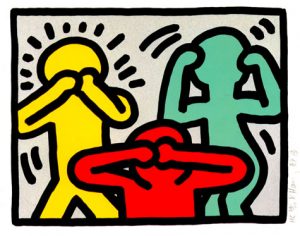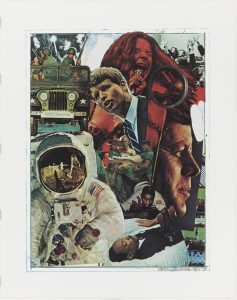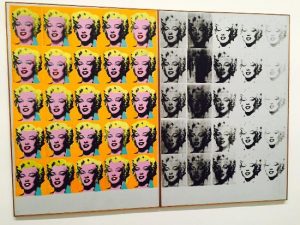Postmodernism is a broad term describing work made in opposition to the ideas and features of modernism. Here I have chosen three examples of postmodern work that has had an impact on my work.
In 1990 Keith Haring tragically died of AIDS related complications at only age 31. Haring’s iconic style was a made of simplified and heavily stylised figures using bold lines and colours. He conveyed such energy through his medium, and he used this energy to tackle difficult issues and show they can become public conversation. An example of this is his 1989 piece Rebel With Many Causes in which we see three figures taking the “hear no evil, see no evil, speak to evil” pose, a criticism of those avoiding such social issues as the AIDS crisis. I admire Haring’s methods of tackling social and political issues through illustration and have a love for his simplistic but energetic style of drawing.

60’s pop artist Robert Rauschenberg is known for his use of non-traditional materials across sculpture, painting and college, and creating statement pieces that often challenge the very definition of what art is and isn’t. I’ve always found the experimental and playful nature of Rauschenberg’s collage work very engaging. A great example of this would be the 1970 piece “Signs”. A reflection on the love, terror and violence the 60’s brought to American culture, with images that were still raw at that time. We see Rauschenberg using collaged images and leaves some canvas revealed to create his signature look. His desire to experiment overrides a need for order and perfection in his work and this is something I look to develop in my own work.

Andy Warhol is widely accepted as the godfather of pop art. With roots in illustration an advertising, Warhol’s work was graphic and clear in content and style. Warhol looked to deconstruct social and cultural norms with interpretive and satyrical meaning behind his work. For instance, his 1962 piece Marylin Diptych isn’t a tribute to the late actress who died just months before the piece was made. Its repetitive nature is reference to mass production, its use of the diptych format highlights the worship of celebrities in American culture and the contrast of colour against monochrome is representative of life and death. I look to Warhol’s work for examples of how simple imagery utilised in the right way can convey satyr and humour whilst making social commentary.
http://www.haring.com/!/art-work/834#.WiblxlKcaHo
https://www.moma.org/collection/works/67925
http://www.tate.org.uk/art/artworks/warhol-marilyn-diptych-t03093

